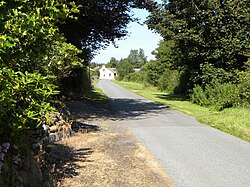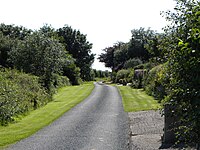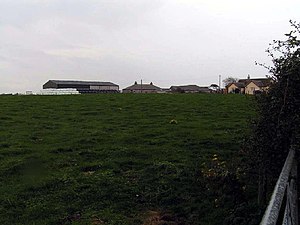Salta
| Salta | |
| Cumberland | |
|---|---|
 Salta | |
| Location | |
| Grid reference: | NY083455 |
| Location: | 54°47’46"N, 3°25’34"W |
| Data | |
| Post town: | Maryport |
| Postcode: | CA15 |
| Dialling code: | 01900 |
| Local Government | |
| Council: | Cumberland |
| Parliamentary constituency: |
Workington |
Salta is a hamlet in the parish of Holme St Cuthbert in north-western Cumberland, a mile south-west of the village of Mawbray, and twenty-five miles south-west of Carlisle. It is a tiny place, with a population of about 35.
Salta can only be accessed from the lane from Mawbray, which goes on to join the B5300 coast road, although two public bridleways provide access over the fields from Hailforth and Mawbray. The hamlet consists of mainly bungalows, and a farm is still in operation in the vicinity. A caravan park, Manor House Park, is situated across the Moss to the southeast, to the southwest of the hamlet of Edderside.

Close by the village is Salta Moss, designated a 'Site of Special Scientific Interest' within the Solway Coast Area of Outstanding Natural Beauty.
The name 'Salta' tells of the village's history: it is from the Old English sealt tir, meaning "salt land", as during Anglo-Saxon times, salt making was a major industry on the Solway Plain. Salta appears in historical documents with several variant spellings, including Sathowe.[1]
The parish church is at Holme St Cuthbert, several miles away.
History
On Salta Moss, an area of common land next to the hamlet, a Bronze Age rapier was discovered in the 1980s.[2] The rapier currently resides in the Tullie House Museum in Carlisle, and archaeologists date it as being crafted as early as 1100 BC.[2]
During the Roman period, the coast at Salta and for some distance either side was fortified as part of the coastal defences which extended beyond the western end of Hadrian's Wall.
From the Anglo-Saxon period and in the Middle Ages, salt pans were dug in the Solway coast here, giving the village its name: there are remains of mediæval salt pans near Milefortlet 21, only a few miles down the coast from Salta. It became a major local industry.
By the 1550s, Salta was participating in a system called "seawake", a night watch to guard the coast against incursions across the Solway by Scottish raiders. [1] These incursions were frequent, and on one occasion in 1592 at Dubmill, near Salta, a Mr Barwise the local miller was taken prisoner by raiders.[1] Peace was not secured until 1603 and the accession of King James I.
The oldest property in Salta is known to date from the 16th century.
During the Second World War, 43 evacuees from the Newcastle-Upon-Tyne area were billeted to the parish of Holme St Cuthbert, and several ended up in Salta.[3] Development in the 20th century saw new houses built, but mainline water and electricity arrived later than in other parts of Britain, due to the small population.
The Kelsick House wind turbine was approved for construction in 2013 in spite of local opposition, six miles to the north-east, to the south of Abbeytown, to join a number of other wind turbines in the area around Salta.
About the village


The shore of Allonby Bay, an inlet of the Solway Firth, is a mere half-a-mile to the west of the hamlet. A beck (a local word meaning "stream") flows through Salta, fed in part by irrigation channels. This beck eventually joins the Black Dub and drains into the Solway Firth at Dubmill.
Salta Moss is a Site of Special Scientific Interest, both for its natural and historical significance, and is itself is located in a designated Area of Outstanding Natural Beauty[4] which covers much of the Solway Plain. The Moss is an area of peatland, containing "mainly oligotrophic semi- fibrous grass-sedge peat" according to Soil Survey Record.[5] It combines characteristics of both a raised bog and a valley mire, and lies atop deposits of glacial sand from the last ice age.[6]
Having been cut with irrigation channels, and been the site of burning and peat working, Salta Moss has different flora than other bogs or mires on the Solway Plain. The Moss today is common ground, but a track runs through it to provide access for local farmers to outlying fields, which surround it. An irrigation ditch has also been dug to provide drainage to the surrounding farmland.
Flora and fauna

Salta, and the Moss in particular, is home to a variety of plant and animal life, including some rare specimens. Adders are seen on the Moss, and prey upon small rodents, such as voles. Many wild bird species inhabit Salta and the surrounding area, including larger species such as pheasants, which are also bred locally for hunting.[4]
The Moss contains several varieties of heather, as well as the purple moor grass Molinia caerulea. Ferns and gorse are common too, and in areas where peat has been cut in the past, there are bog mosses, the bog bean Menyanthus trifoliata, and marsh pennywort.
Outside links
| ("Wikimedia Commons" has material about Salta) |
References
- ↑ 1.0 1.1 1.2 Kendal (1929). "'Records : The Holm under Elizabeth', in Register and Records of Holm Cultram". in Francis Grainger and W G Collingwood. British History Online. pp. 167–176. http://www.british-history.ac.uk/n-westmorland-records/vol7/pp167-176. Retrieved 13 December 2014.
- ↑ 2.0 2.1 "The Celtic Solway". Holme St Cuthbert History Group. http://myweb.tiscali.co.uk/hstchg/celts.htm. Retrieved 18 October 2009.
- ↑ "Holme St Cuthbert history group – The Evacuees". http://myweb.tiscali.co.uk/hstchg/evacueestxt.htm.
- ↑ 4.0 4.1 Salta Moss: Natural England
- ↑ Beard, G. R.. Soil Survey Record. Soil Survey of England and Wales. p. 10. https://books.google.com/books?id=dFdLAAAAYAAJ.
- ↑ SSSI listing and designation for Salta Moss
